Yet aside from the anchor in the Carpathians, Russia did not achieve any truly defensible borders. Expansions to the Baltic and Black Seas did end the external threat from the Cossacks and Balts of ages past, but at the price of turning those external threats into internal ones. Russia also expanded so far and fast that holding the empire together socially and militarily became a monumental and ongoing challenge (today Russia is dealing with the fact that Russians are barely a majority in their own country). All this to achieve some semblance of security by establishing buffer regions.
But that is an issue of empire management. Ultimately the multi-directional threat defined Muscovy’s geopolitical problem. There was a constant threat from the steppes, but there was also a constant threat from the west, where the North European Plain allowed for few natural defenses and larger populations could deploy substantial infantry (and could, as the Swedes did, use naval power to land forces against the Muscovites). The forests provided a degree of protection, as did the sheer size of Russia’s holdings and its climate, but in the end the Russians faced threats from at least two directions. In managing these threats by establishing buffers, they were caught in a perpetual juggling act: east vs. west, internal vs. external.
The geography of the Russian Empire bequeathed it certain characteristics. Most important, the empire was (and remains) lightly settled. Even today, vast areas of Russia are unpopulated while in the rest of the country the population is widely distributed in small towns and cities and far less concentrated in large urban areas. Russia’s European part is the most densely populated, but in its expansion Russia both resettled Russian ethnics and assimilated large minorities along the way. So while Moscow and its surroundings are certainly critical, the predominance of the old Muscovy is not decisively ironclad.
The result is a constant, ingrained clash within the Russian Empire no matter the time frame, driven primarily by its size and the challenges of transport. The Russian empire, even excluding Siberia, is an enormous landmass located far to the north. Moscow is at the same latitude as Newfoundland while the Russian and Ukrainian breadbaskets are at the latitude of Maine, resulting in an extremely short growing season. Apart from limiting the size of the crop, the climate limits the efficiency of transport — getting the crop from farm to distant markets is a difficult matter and so is supporting large urban populations far from the farms. This is the root problem of the Russian economy. Russia can grow enough to feed itself, but it cannot efficiently transport what it grows from the farms to the cities and to the barren reaches of the empire before the food spoils. And even when it can transport it, the costs of transport make the foodstuffs unaffordable.
Population distribution also creates a political problem. One natural result of the transport problem is that the population tends to distribute itself nearer growing areas and in smaller towns so as not to tax the transport system. Yet these populations in Russia’s west and south tend to be conquered peoples. So the conquered peoples tend to distribute themselves to reflect economic rationalities, while need for food to be transported to the Russian core goes against such rationalities.
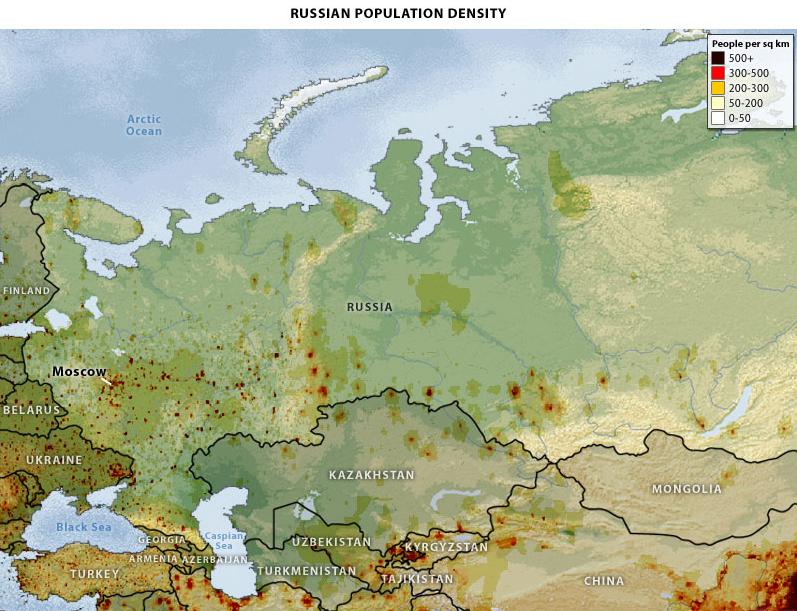
Faced with a choice of accepting urban starvation or the forcing of economic destitution upon the food-producing regions (by ordering the sale of food in urban centers at prices well below market prices), Russian leaders tend to select the latter option. Joseph Stalin certainly did in his efforts to forge and support an urban, industrialized population. Force-feeding such economic hardship to conquered minorities only doubled the need for a tightly controlled security apparatus.
The Russian
geography meant that Russia either would have a centralized government
— and economic system — or it would fly apart, torn by nationalist
movements, peasant uprisings and urban starvation. Urbanization, much less
industrialization, would have been impossible without a strong center.
Indeed, the Russian Empire or Soviet Union would have been impossible.
The natural tendency of the empire and Russia itself is to disintegrate.
Therefore, to remain united it had to have a centralized bureaucracy responsive
to autocratic rule in the capital and a vast security apparatus that compelled
the country and empire to remain united. Russia’s history is one of controlling
the inherently powerful centrifugal forces tearing at the country’s fabric.
Russia, then,
has two core geopolitical problems. The first is holding the empire together.
But the creation of that empire poses the second problem, maintaining internal
security. It must hold together the empire and defend it at the same time,
and the achievement of one goal tends to undermine efforts to achieve the
other.
Geopolitical Imperatives
To secure the Russian core of Muscovy, Russia must:
· Expand north and east to secure a redoubt in climatically hostile territory that is protected in part by the Urals. This way, even in the worst-case scenario (i.e., Moscow falls), there is still a “Russia” from which to potentially resurge.
· Expand south to the Caucasus and southeast into the steppes in order to hamper invasions of Asian origin. As circumstances allow, push as deeply into Central Asia and Siberia as possible to deepen this bulwark.
· Expand as far west as possible. Do not stop in the southwest until the Carpathians are reached. On the North European Plain do not stop ever. Deeper penetration increases security not just in terms of buffers; the North European Plain narrows the further west one travels making its defense easier.
· Manage the empire with terror. Since the vast majority of Russian territory is not actually Russian, a very firm hand is required to prevent myriad minorities from asserting regional control or aligning with hostile forces.
· Expand to warm water ports that have open-ocean access so that the empire can begin to counter the economic problems that a purely land empire suffers.
Given the geography of the Russian heartland, we can see why the Russians would attempt to expand as they did. Vulnerable to attack on the North European Plain and from the Central Asian and European steppes simultaneously, Russia could not withstand an attack from one direction — much less two. Apart from the military problem, the ability of the state to retain control of the country under such pressure was dubious, as was the ability to feed the country under normal circumstances — much less during war. Securing the Caucasus, Central Asia and Siberia was the first — and easiest — part of dealing with this geographic imbroglio.
Given the geography of the Russian heartland, we can see why the Russians would attempt to expand as they did. Vulnerable to attack on the North European Plain and from the Central Asian and European steppes simultaneously, Russia could not withstand an attack from one direction — much less two. Apart from the military problem, the ability of the state to retain control of the country under such pressure was dubious, as was the ability to feed the country under normal circumstances — much less during war. Securing the Caucasus, Central Asia and Siberia was the first — and easiest — part of dealing with this geographic imbroglio.
The western expansion was not nearly so “simple.” No matter how far west the Russians moved on the European plain, there was no point at which they could effectively anchor themselves. Ultimately, the last effective line of defense is the 400 mile gap (aka Poland) between the Baltic Sea and Carpathian Mountains. Beyond that the plains widen to such a degree that a conventional defense is impossible as there is simply too much open territory to defend. So the Soviet Union pressed on all the way to the Elbe.
At its height, the Soviet Union achieved all but its final imperative of securing ocean access. The USSR was anchored on the Carpathians, the Black Sea, the Caucasus and the Urals, all of which protected its southern and southwestern flanks. Siberia protected its eastern frontier with vast emptiness. Further to the south, Russia was anchored deeply in Central Asia. The Russians had defensible frontiers everywhere except the North European Plain, ergo the need to occupy Germany and Poland.
Thus one could also say that, the Russian military will always be a product of Russian history, Russian geopolitical imperatives and Russian thinking. It will never be measurable entirely by Western military standards. At the same time, the collapse of the Soviet Union and the realities of the 21st century demand some of the most radical military reform in Russia’s modern history. And this reform is not simply a matter of getting a fresh start. In order to build a new military, Moscow must also deconstruct what remains of Soviet military structure and organization. It must push past much of the Soviet-era thinking that has governed the Russian military for the better part of a century. And it must do so while working against the grain of profound institutional inertia.
This inertia is embodied in the upper echelons of the officer corps, something we pointed out nearly 10 years ago in our 2000-2010 decade forecast we also indicated that only the very top rung of Russian leadership had been replaced since the collapse of the Soviet Union, leaving much of the old Soviet mindset still firmly entrenched. Not only is this cadre of senior officers the intellectual product of Soviet military education, but the upper echelons in which they reside were both incidentally and deliberately overloaded.
Incidentally, because Moscow held tightly to the reins of the Soviet military in the days of the Soviet Union, the majority of officers were Russian. When the union collapsed, a disproportionate number of enlisted personnel — conscripts and volunteers alike — from the western Warsaw Pact countries and Soviet republics were lost while the vast majority of the officers remained part of the Russian military. The result was that the ratio of officers to enlisted personnel in the Russian military became extremely high.
Deliberately, because every Russian or Soviet leader before Vladimir Putin was concerned about the military consolidating against the Kremlin, even though Russia has not faced a successful military coup in over two centuries. As a result of this paranoia, various inefficiencies have been deliberately and systematically built into the military by many leaders in order to keep the officers too numerous and disorganized to ever achieve such consolidation.
Indeed, future President Boris Yeltsin helped turn the tide against a 1991 coup supported by rogue elements of the military against former President Mikhail Gorbachev. Upon becoming president, Yeltsin greatly increased the number of officers both to keep the military in disarray and to insert political allies into the military.
In large part due to Yeltsin’s efforts, the officer corps today remains immense, with over 300,000 members, tipping the scales at more than 30 percent of the total force (including conscripts). As a point of comparison, commissioned officers in the U.S. Army amount to 15 percent of its personnel, a percentage far more commensurate with modern, Western models. Although the Russian military cannot be judged or understood entirely through the prism of Western military thought, it is a bloated, top-heavy and ultimately unsustainable force structure — even for Russia.
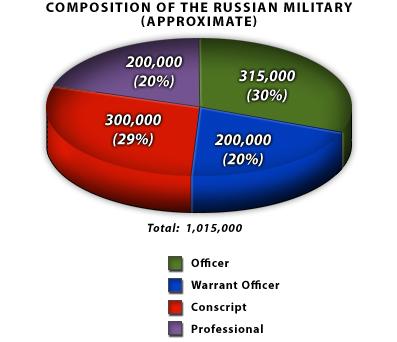
So far, progress in reducing the number of officers has been stop-and-go. But the transition of presidential power from Putin to Dmitri Medvedev has now been completed, which could position the Kremlin to challenge the entrenched interests of more than 1,100 generals and admirals. These general officers have also been an expensive financial burden, since they occupy the most senior and well-paid positions with the most assistants and perks. Efforts are underway to shrink their ranks by some 200, bringing the figure closer to, though still greater than, the U.S. military’s general-officer ranks (fewer than 900).
The current goal of reductions to 150,000 officers by 2012 — a cut of more than 50 percent — is nothing if not ambitious, but even getting in that range would be an enormous step for Russia’s military because it would free up resources and help increase the institutional agility of the armed forces as a whole. Indeed, the reduction in the senior officer ranks is even more dramatic than the 50 percent cut suggests, since the Kremlin hopes to dramatically expand the ranks of junior officers and noncommissioned officers (NCOs).
But concerns about job security in the midst of the global financial crisis and a tumbling ruble have already led Prime Minister Putin to make public assurances that cuts to the ranks of the military will not be precipitous and that only those near retirement will be let go — with pension and (a tradition in Russia) housing. No matter how the Kremlin manages it, significant rises in entitlement spending are in the cards for the military budget, and questions remain about just how quickly Russia will be able to push forward with major reductions in the senior officer ranks.
Culture
For the remainder of the Russian military, there are two broad issues: culture and demographics. The new “permanent readiness forces,” poised and prepared for quick deployment in a crisis, will be smaller and more agile, with different chains of command. This will necessarily increase reliance on junior officers and NCOs. By pushing command down to the lower levels, the demand for initiative and small-unit leadership will rise accordingly. But there is little tradition in the Russian military for either, and it is not clear how well young officers and NCOs will cope, even though an expanded training pipeline is in the works.
There is also a culture of violence and leadership through brutality in the Russian military. The heart of this problem is the conscription program, which remains an enormous embarrassment for the Kremlin. Rampant brutality and hazing known as dedovshchina (formerly practiced by those in their second year of conscription before the two-year term of service was reduced to one year) often results in serious injury and death, including suicide. (Dedovshchina reportedly resulted in the loss of several hundred conscripts in 2007, several years after the problem had been identified and reforms had begun to be implemented.)
Not unrelated is a culture of drunkenness, drug abuse and desertion — not only among conscripts but also in the ranks of professional contract soldiers. As the U.S. military found after Vietnam, this sort of cultural affliction can take a decade or more to remedy, and unlike the U.S. military in Vietnam, Russia hosts major heroin smuggling routes from Afghanistan. Black-market alcohol, as well as illicit drugs, are coursing through Russia’s veins, making the reduction of alcoholism, drug abuse and corruption even more complicated for the Russian military.
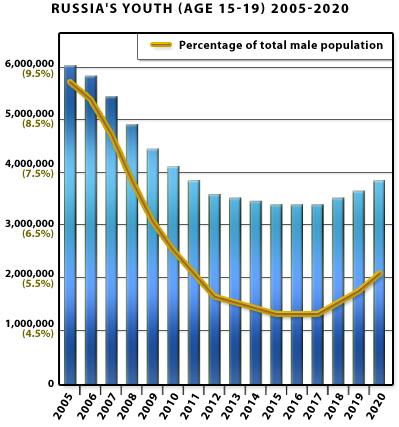
A far more concrete problem is demographics. Junior officers, NCOs, professional soldiers and conscripts are all going to come from essentially the same pool (even with some variation in age and educational achievement). By cutting the conscripted service period in half, Russia has effectively doubled the number of youth it must conscript each year. While eligibility for the draft runs for nearly a decade, technically, the vast majority of youth are conscripted at age 18, and Russia is now attempting to conscript young men who never knew the Soviet Union. The 1990s were not a particularly buoyant time for Russia in terms of the birth rate, and the number of Russian men turning 18 each year is declining, just when the Kremlin needs to press more and more of them into service. Although there will be a small rebound starting in 2017, according to birth-rate projections, nearly a decade of dramatic population decline will occur before then, and long-term prospects are much worse.
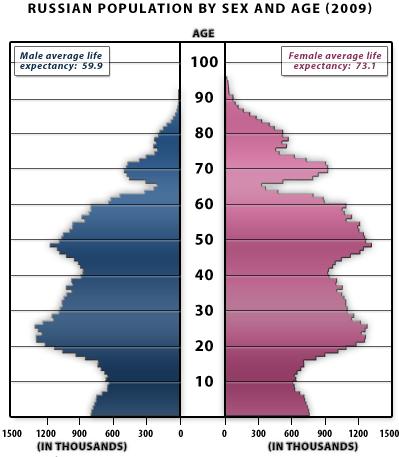
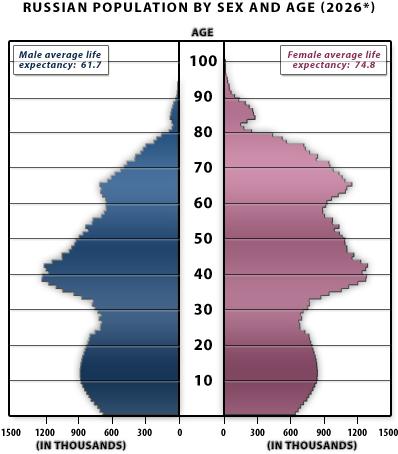
The declining youth population is a reminder that Russia is approaching a much more problematic demographic crisis beyond 2025 — namely, the decline of Russian society as a whole. Birth rates are not sufficient to sustain the population, infertility, AIDS and alcoholism are rampant and the Russian people are growing increasingly unhealthy with diminishing life spans.
Finances
The other major problem is money. Awash in cash during Putin’s presidency due in large part to high commodity prices, Russia was able to sock away some US$750 billion in total currency reserves. This sum has begun to erode because of the invasion of Georgia and the ongoing financial crisis and is already down to around US$370 billion. Russia still enjoys vast reserves, but the ruble continues to tumbleas the financial crisis works it way through the Russian economy. Russia may be able to sustain some planned increases in military spending by tapping its reserves, but the implications of the financial crisis on Russian military reform remain to be seen.
Actual spending on Russian national defense — around US$40 billion in 2008 — has continued to rise steadily in real rubles, but as a portion of gross domestic product and the overall budget it has remained relatively constant. What this means is that the Kremlin has not been excessively lavish with national defense even when its monetary resources were expanding dramatically. Instead it has exercised the power of the purse — now embodied in the appointment of a tax man, Anatoly Serdyukov, as defense minister. The Kremlin is all too aware of how much money is being lost through corruption, inefficiency and waste (Moscow is willing to acknowledge some US$75 million in 2007, but the real figure is almost certainly much higher).
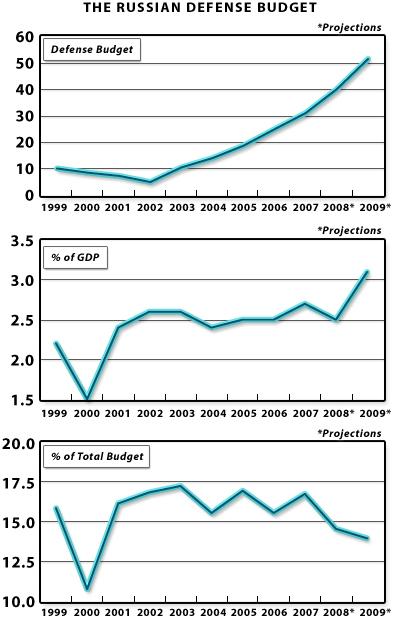
The global financial crisis comes at a particularly difficult point in Russian military modernization. Increases in defense spending and procurement had been talked about before, but the confluence of a flood of petrodollars and the successful transition of power to President Medvedev in 2008 held the promise, at last, of actual implementation. Then came the onslaught of the worldwide recession. While the Kremlin may continue to sustain military spending out of its reserves, its budgets will undoubtedly be tighter than anticipated for the duration of the crisis.
Further complicating financial matters is an ongoing clan war in the Kremlin between the two main factions working under Prime Minister Putin. The faction led by Vladislav Surkov controls both the country’s finances and the GRU, Russia’s shadowy military intelligence agency, while the defense establishment (both ministerial and industrial) is controlled by the other faction, led by Igor Sechin. This conflict has likely played a role in impeding the implementation of military reform.
But even if the clan war subsides and Moscow’s coffers stabilize, money cannot solve everything. The myriad obstacles in the way of genuine military reform are daunting ones, difficult to overcome even in the best of times. And these are not the best of times. Russia has devised ambitious military reform plans and revised time and again to accommodate the realities of the moment, often departing from the plans’ original goals. This time around, as Russia tries to reassert itself as a regional power, broad military reform is a critical priority for the Kremlin. Some progress is certainly in the cards, and although it will not likely conform to previously articulated plans, it could lead to limited successes that are sufficient for Moscow’s needs, such as the Georgian operation in August 2008.